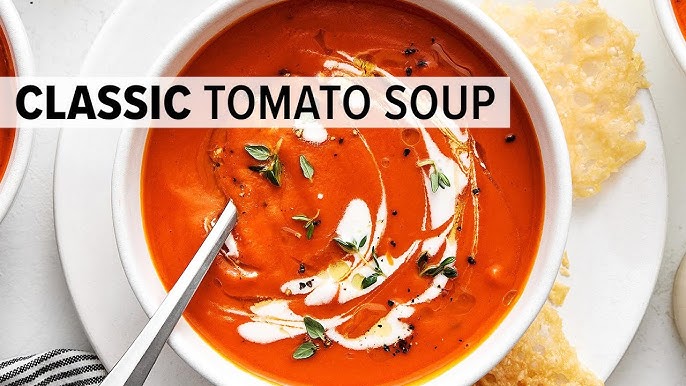Best Tomato Soup Recipe: Tomato soup is like a warm hug in a bowl. It’s nostalgic, it’s satisfying, and it hits just the right spot whether it’s a rainy afternoon or a chilly winter night. For many of us, tomato soup brings back memories of childhood, sitting at the kitchen table with a grilled cheese sandwich on the side. That tangy-sweet flavor of ripe tomatoes, mixed with herbs and just the right amount of creaminess, makes it an all-time favorite.
Beyond just being delicious, tomato soup is one of the simplest and most budget-friendly meals you can make. You don’t need fancy ingredients or hours of prep work. Whether you’re a kitchen newbie or a seasoned home cook, this dish delivers every time. It’s versatile too—you can spice it up, keep it smooth, add croutons, or swirl in cream. However you like it, tomato soup adapts.
Health Benefits of Tomato Soup
It’s not just tasty—tomato soup is also surprisingly good for you. Tomatoes are rich in lycopene, a powerful antioxidant known for its cancer-fighting properties. They’re also packed with vitamin C, potassium, folate, and vitamin K. When you make your own soup from fresh ingredients, you control the salt, sugar, and fat content, which makes it a much healthier alternative to canned versions.
Tomato soup is low in calories, especially if you skip the cream or use a plant-based alternative. It’s also hydrating, thanks to its high water content. If you’re trying to get more veggies into your diet, soup is a great vehicle. And let’s not forget the comfort factor—warm soup can be soothing for digestion, especially when you’re feeling under the weather.
Ingredients You’ll Need
Fresh Ingredients
To make the best tomato soup, quality ingredients are key. Here’s what you’ll need:
- Fresh tomatoes – Roma or vine-ripened work best
- Onion – Adds sweetness and depth
- Garlic – Brings out the umami flavors
- Carrot – Balances the acidity of tomatoes
- Basil – Fresh basil elevates the taste
- Cream or milk (optional) – For a creamy texture
Fresh tomatoes are the heart of this soup. If you can, use ripe, in-season tomatoes for the best flavor. Roasting them beforehand is an optional step that deepens the taste even more.
Pantry Staples
Even though fresh ingredients shine in this recipe, pantry staples help bring it all together:
- Olive oil or butter – For sautéing
- Vegetable broth or chicken stock – The soup base
- Salt and pepper – Essential for seasoning
- Sugar (a pinch) – Balances acidity
- Bay leaf or dried herbs (optional) – Adds earthy notes
You probably already have most of these in your kitchen, which makes this a great last-minute meal when you’re short on time but still want something hearty and homemade.
Equipment You’ll Need
Kitchen Tools for Smooth Soup
No fancy gadgets required here—just a few basics:
- Large pot or Dutch oven – For cooking everything in one place
- Blender or immersion blender – To puree the soup
- Cutting board and knife – For chopping veggies
- Ladle – To serve the soup
An immersion blender is super handy because you can blend the soup right in the pot without dirtying more dishes. But a regular blender works just as well; just be careful blending hot liquids—work in batches and don’t overfill the jar.
Step-by-Step Tomato Soup Recipe
Step 1: Prepping the Ingredients
Start by washing and chopping your fresh tomatoes. Dice the onions, mince the garlic, and peel and slice the carrots. If you’re using fresh basil, chop it roughly. Have all your ingredients ready to go, as this will make the cooking process smooth and stress-free.
A quick tip: If you’re roasting your tomatoes for extra flavor, cut them in halves, drizzle with olive oil, and roast at 400°F (200°C) for 20–30 minutes. This step caramelizes the sugars in the tomatoes and gives the soup a deeper, richer flavor.
Step 2: Sautéing for Flavor
Heat olive oil or butter in a large pot over medium heat. Add the onions and sauté for 5–7 minutes until soft and translucent. Toss in the garlic and carrots, and cook for another 5 minutes. This is the flavor foundation of your soup, so don’t rush it.
As the veggies soften, the kitchen will start to smell amazing. You can add a bay leaf here or sprinkle in dried thyme or oregano for extra aroma. The goal is to let the flavors marry even before the tomatoes go in.
Step 3: Simmering the Soup
Now it’s time to add the star of the show—those gorgeous tomatoes. If you roasted them, toss them in along with all the juices from the baking tray. If you’re using raw chopped tomatoes, simply add them to the sautéed veggies. Stir everything together and let the mixture cook for about 5-7 minutes so the tomatoes start to break down.
Next, pour in your broth—vegetable or chicken stock both work beautifully. Stir in a pinch of sugar to balance out the acidity of the tomatoes. Season with salt and pepper to taste. At this stage, you can also toss in a bay leaf or a few sprigs of thyme.
Bring the soup to a gentle boil, then reduce the heat and let it simmer uncovered for about 20–30 minutes. The tomatoes should be soft, the carrots tender, and the flavors fully melded. This simmering stage is crucial because it’s where all the depth and complexity come from.
Step 4: Blending to Perfection
Once your soup has simmered to perfection, it’s time to blend it into that silky, smooth consistency we all love. If you have an immersion blender, you can do this right in the pot. Just be cautious—it’s hot, so blend slowly to avoid splashing.
If you’re using a countertop blender, let the soup cool slightly before transferring it in batches. Don’t fill the blender more than halfway, and keep the lid slightly ajar to let steam escape (cover with a towel to avoid messes). Blend until completely smooth and velvety.
Return the soup to the pot and taste. Adjust seasoning if needed—maybe a bit more salt or a pinch more sugar. If you like your soup ultra-smooth, you can strain it through a fine-mesh sieve at this point, but that’s totally optional.
Step 5: Final Touches
This is the fun part where you personalize your soup. For a creamier texture, stir in a splash of heavy cream, milk, or even coconut milk for a dairy-free twist. If you like a bit of spice, add a pinch of chili flakes or smoked paprika.
Want to keep it fresh and herby? Throw in some chopped fresh basil or parsley. Give it one last good stir and let everything heat through gently for another 2–3 minutes.
Now, your tomato soup is ready to serve! Ladle it into bowls, top with a drizzle of cream, a few basil leaves, or crunchy croutons, and you’ve got a comforting masterpiece.
Tips for the Perfect Tomato Soup
- Use ripe, in-season tomatoes: They make all the difference in flavor.
- Roast your tomatoes: It takes a little extra time but delivers next-level depth.
- Balance acidity: A small pinch of sugar helps mellow out the tang.
- Blend carefully: Always blend hot soup with caution to avoid burns.
- Finish with flair: Cream, herbs, or a drizzle of olive oil add a gourmet touch.
Also, don’t be afraid to get creative—your taste buds are the real judge. Try experimenting with roasted garlic, caramelized onions, or even a splash of balsamic vinegar.
Serving Suggestions
Tomato soup pairs with more than just grilled cheese (although that’s a classic for a reason). Here are some delicious serving ideas:
- Crusty bread or garlic toast: Perfect for dipping.
- Grilled cheese sandwiches: The ultimate comfort food combo.
- Salads: A fresh green salad balances the richness.
- Cheese crisps or parmesan chips: Add a salty crunch.
- Toppings: Swirls of cream, pesto, croutons, or shredded cheese elevate the look and taste.
- Want a meal that feels fancy? Serve it as a starter at dinner parties in small cups or bowls, garnished with microgreens and a touch of truffle oil.
Common Mistakes to Avoid
Even with a simple recipe like tomato soup, a few common pitfalls can trip you up. Here’s what to steer clear of to make sure your soup comes out just right:
1. Using under-ripe or bland tomatoes
Tomatoes are the heart of this dish, and their flavor matters. Using under-ripe or tasteless tomatoes will result in a soup that lacks depth and sweetness. Always choose ripe, juicy tomatoes or go for canned San Marzano tomatoes if fresh ones aren’t in season.
2. Skipping the sautéing step
It might seem tempting to just throw everything into a pot and boil it, but skipping the step of sautéing the onions, garlic, and carrots will rob your soup of complexity. This step caramelizes the sugars and builds a rich base of flavor.
3. Not seasoning properly
Tomatoes are naturally acidic, so a bit of sugar helps balance that. Also, don’t be shy with salt and pepper—season in layers as you cook. Taste as you go and adjust near the end.
4. Overcooking or burning the ingredients
Cook your soup at a gentle simmer. High heat can scorch the bottom and give your soup a burnt taste. Also, keep an eye on garlic—it can become bitter if overcooked.
5. Blending too early
Make sure everything is soft and fully cooked before you blend. If you blend too soon, the soup may be gritty or uneven in texture.
Avoiding these mistakes will take your soup from “okay” to “absolutely amazing.”
Variations You Can Try
Tomato soup is super versatile, and you can switch it up in countless ways depending on your mood or dietary needs. Here are some creative twists:
1. Creamy Tomato Basil Soup
Add extra cream and a generous handful of fresh basil leaves during blending. This version is silky smooth and aromatic—perfect for when you want something a little indulgent.
2. Spicy Tomato Soup
Add red chili flakes, cayenne pepper, or even a splash of hot sauce. This variation brings heat and is perfect for spice lovers.
3. Roasted Red Pepper and Tomato Soup
Roast red bell peppers along with your tomatoes, then blend them together. The peppers add a smoky sweetness that pairs beautifully with the acidity of the tomatoes.
4. Tomato Lentil Soup
Toss in a cup of red lentils before simmering. It adds protein, fiber, and a bit of heartiness without changing the flavor much.
5. Vegan Tomato Soup
Skip the cream and use coconut milk or cashew cream. Make sure your broth is vegetable-based. It’s just as satisfying and completely dairy-free.
By experimenting with these versions, you’ll never get bored of tomato soup. It’s one base recipe with endless possibilities.
Storing and Reheating Leftovers
One of the best things about tomato soup? It stores beautifully. In fact, it might even taste better the next day when all the flavors have had time to meld together.
Storing:
- Fridge: Let the soup cool completely, then transfer it to an airtight container. It will stay fresh in the fridge for up to 5 days.
- Freezer: Tomato soup freezes like a dream. Pour it into freezer-safe containers or silicone freezer bags. It can last up to 3 months in the freezer.
Reheating:
- For the stovetop, pour the soup into a saucepan and heat over medium-low heat until warm, stirring occasionally.
- For the microwave, heat in a microwave-safe bowl in 30-second increments, stirring in between, until heated through.
If you’re reheating frozen soup, let it thaw in the fridge overnight or place the container in warm water until it loosens enough to pour into a pot.
FAQs about Best Tomato Soup Recipe
Q1: What tomatoes are best for homemade tomato soup?
Roma or San Marzano tomatoes are perfect. They’re naturally sweet, low on seeds, and bring that deep tomato flavor you crave in a soup.
Q2: Can I use canned tomatoes instead of fresh?
Absolutely. Canned whole peeled tomatoes work great and save time. Just make sure they’re high quality—preferably Italian or organic.
Q3: How do I make tomato soup creamy?
Add heavy cream, coconut milk, or a swirl of Greek yogurt. Blend until smooth for that velvety texture.
Q4: Is tomato soup healthy?
Yes! Tomato soup is rich in vitamins A and C, and lycopene—an antioxidant powerhouse. Skip the heavy cream if you’re watching calories.
Q5: What’s the best way to thicken tomato soup?
Simmer it longer, or stir in a spoonful of tomato paste or a diced cooked potato. For extra richness, try a roux or a splash of cream.
Q6: Can I freeze tomato soup?
Definitely. Let it cool completely, then store in airtight containers. It freezes well for up to 3 months.
Q7: What goes well with tomato soup?
Grilled cheese, garlic bread, or a fresh green salad. Classic comfort food vibes.
Conclusion
Tomato soup is one of those rare dishes that checks all the boxes—it’s cozy, delicious, healthy, and endlessly adaptable. Whether you’re making it for a weeknight dinner, a sick day, or a fancy starter, this homemade version beats any canned soup hands-down.
By choosing fresh ingredients, layering flavors carefully, and blending it to creamy perfection, you’ll have a soup that tastes like it came from a restaurant. And the best part? It’s easy enough for anyone to make.
So go ahead, whip up a pot of this comforting classic, and make it your own. Your taste buds (and your dinner guests) will thank you.



